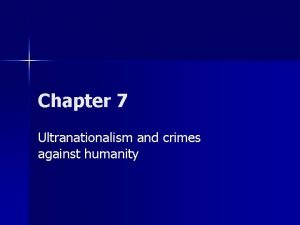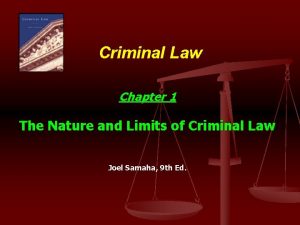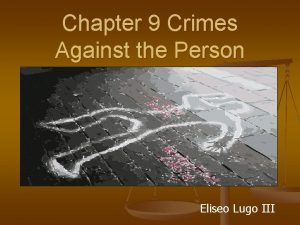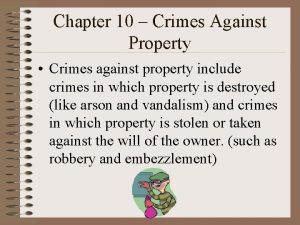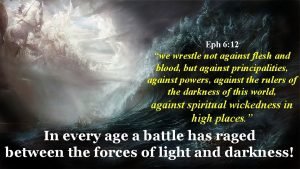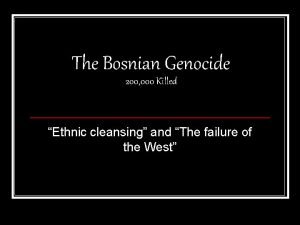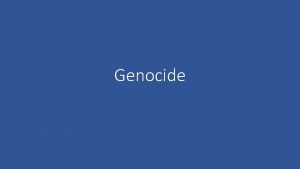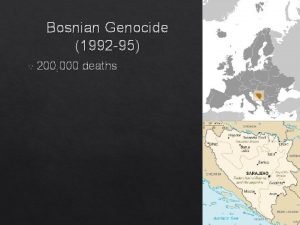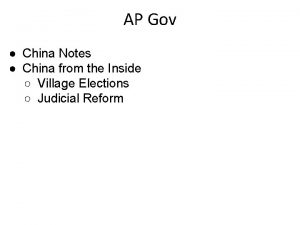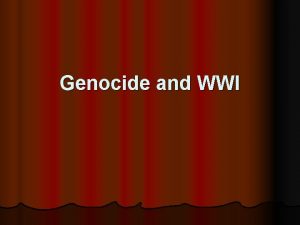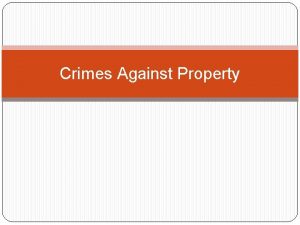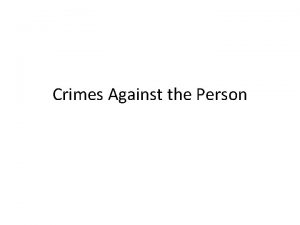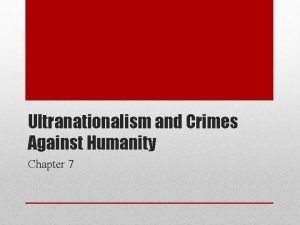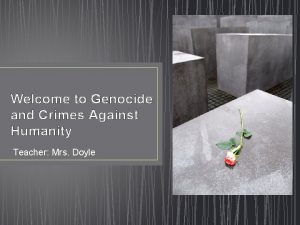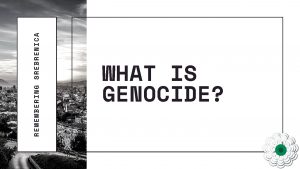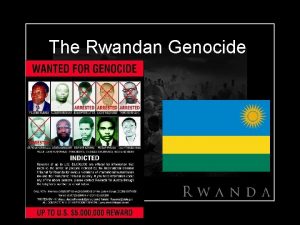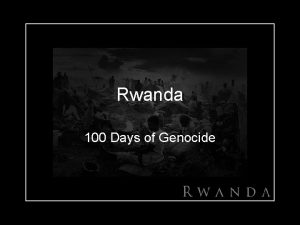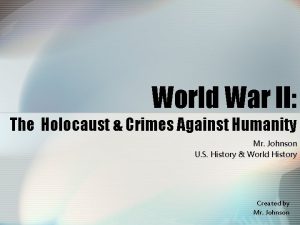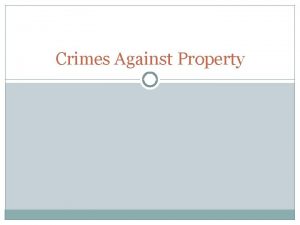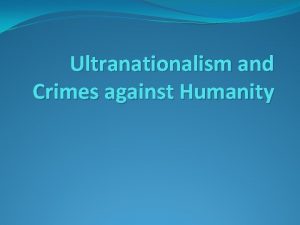Genocide War Crimes and Crimes against humanity Presented













- Slides: 13

Genocide, War Crimes and Crimes against humanity Presented by STUDENT NAME

Table of Contents 1. Introduction 1. 1 Define the terms: a) Genocide, b)War Crimes and c) Crimes Against Humanity 2. United Nations Convention on the Prevention and Punishment of the Crime of Genocide (CPPCG) 2. 1 Weaknesses and Challenges 3. Case Study: South Sudan 3. 1 Country profile 3. 2 Causes of conflict 3. 3 Challenges & Solutions 4. Conclusion References

1. Introduction 1. 1 Define the terms: a) • Genocide First used by Raphael Lemkin, a Jewish lawyer, in 1944 Genos (race, tribe) and cide (killing) • Definition of genocide as contained in Article 2 of the Convention on the Prevention and Punishment of the Crime of Genocide : “Genocide means any of the following acts committed with intent to destroy in whole or in part, a national, ethnical racial or religious group, as such: a. Killing members of the group; b. Causing serious bodily or mental harm to members of the group; c. Deliberately inflicting on the group conditions of life calculated to bring about its physical destruction in whole or in part; d. Imposing measures intended to prevent births within the group; (e) forcibly transferring children of the group to another group. ”

1. Introduction b) War Crimes • “Violations of international humanitarian law (treaty or customary law) that incur individual criminal responsibility under international law” (Rome Statute of the International Criminal Court); • such as: wilful killing, torture or inhuman treatment, intentionally directing attacks against civilians, etc. c) Crimes Against Humanity • “Acts when committed as part of a widespread or systematic attack directed against any civilian population” (Rome Statute of the International Criminal Court) • such as murder, extermination, torture, etc.

2. United Nations Convention on the Prevention and Punishment of the Crime of Genocide (CPPCG) • Approved in 1948 by the United Nations, entered into force in January 1951. • Ratified by 149 countries (as of January 2018)

2. United Nations Convention on the Prevention and Punishment of the Crime of Genocide (CPPCG) 2. 1 Weaknesses and Challenges Table One: Genocide and the International Response Prevent Punish East Pakistan (1971) -- -- Burundi (1972) -- -- Cambodia (1975 -1979) -- -- Nigeria (1967 -1970) -- -- Guatemala (1981 -1983) -- -- Iraq (1987 -1989) -- +/-- Bosnia I (1992 -1994) +/-- + Bosnia II (1994 -1995) + + Rwanda (1994) -- + Sudan (2003 -2007*) -- * + the Genocide was stopped with the use of force -- the Convention has been ignored or ineffectively used +/- the response has been mixed; *the genocide is still occurring Source: https: //scholarworks. gsu. edu/cgi/viewcontent. cgi? article=1016&context=political_science_theses

2. United Nations Convention on the Prevention and Punishment of the Crime of Genocide (CPPCG) 2. 1 Weaknesses and Challenges • UN Security Council: Opposite opinions • Countries’ willingness to intervene • Lack of enforcement mechanisms • Preventive action needs to be improved

3. Case Study: South Sudan 3. 1 Country profile • Genocide, ethnic cleansing happening in South Sudan since the civil war broke out in 2013 • 50, 000 people have been killed • 2. 3 million people have been displaced • Famine was declared in February 2017 (FAO) • May 2017: President Kiir announces unilateral ceasefire and launches a national dialogue

3. Case Study: South Sudan 3. 2 Causes of conflict • 2011: Gained Independence from mostly Muslim Sudan • Contains more than 60 ethnic groups. Two largest groups: Dinka vs. Nuer • US and international community withdrew after independence. • Tensions intensify: Riek Machar heavily criticizes Salva Kiir’s government policies • 2013: Civil war breaks out • Hate speech encourages violence against civilians Political conflict turns into ethnic conflict

3. Case Study: South Sudan 3. 3 Challenges & Solutions • Competition for resources • Intervention of neighbouring countries (Sudan, Uganda) • Flow of weapons into the region, from Chinese national weapons manufacturer NORINCO • UN is asking for immediate intervention, but no sign of cooperation • US imposes an unilateral arms embargo: more symbolic than useful • US is pushing for a UN arms embargo unlikely to pass UN Security Council • Current peace talks between Salva Kiir and Riek Machar finally an end to the civil war

4. Conclusion • CPPCG still needs improvement for more effectiveness • Ignorance and unwillingness to intervene extend conflicts • Intervention of the international community is slow or ineffective

Any questions or comments? Thank you for listening!

References • http: //endgenocide. org/learn/what-is-genocide/ • http: //www. preventgenocide. org/law/convention/text. htm • https: //www. britannica. com/topic/genocide#ref 283848 • https: //scholarworks. gsu. edu/cgi/viewcontent. cgi? article=1016&context=political_science_theses • https: //www. vox. com/world/2016/12/8/13817072/south-sudan-crisis-explained-ethnic-cleansing-genocide • http: //www. un. org/en/genocideprevention/war-crimes. html • https: //paanluelwel. com/2017/04/23/the-politics-of-genocide-and-the-failure-to-protect-human-rights-in-southsudan/ • https: //www. economist. com/middle-east-and-africa/2016/12/10/the-chaos-in-south-sudan-keeps-getting-worse • http: //www. fao. org/emergencies/countries/detail/en/c/147627 • https: //www. bbc. com/news/world-africa-14019202 • https: //www. hrw. org/news/2018/02/02/time-ripe-un-arms-embargo-south-sudan • https: //www. nytimes. com/aponline/2018/06/22/world/africa/ap-af-south-sudan-civil-war. html • https: //www. washingtonpost. com/national/south-sudans-rival-leaders-set-to-meet-again-insudan/2018/06/25/8 ac 7 c 2 de-7859 -11 e 8 -ac 4 e-421 ef 7165923_story. html? utm_term=. 02 d 90 b 776382
 How does ultranationalism lead to crimes against humanity
How does ultranationalism lead to crimes against humanity What are the crimes against public order?
What are the crimes against public order? What are the crimes against public order?
What are the crimes against public order? Chapter 9 crimes against the person
Chapter 9 crimes against the person Crimes against property examples
Crimes against property examples Crimes against society
Crimes against society For we wrestle not against flesh
For we wrestle not against flesh Bosnian genocide death toll
Bosnian genocide death toll Geno latin
Geno latin Cambodian genocide classification
Cambodian genocide classification Un definition of genocide
Un definition of genocide Bosnian genocide symbolization
Bosnian genocide symbolization Cultural genocide china
Cultural genocide china Define genocide
Define genocide
